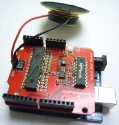oconnor.jb
Member Since: February 7, 2014
Country: United States
-
I'm having a lot of fun with this panel, and it works well. But, every now and then it will be clicking along, displaying what I send it, and then it will start flashing random pixels and blobs of pixels, and then it will settle down and start displaying accurate output again. Any ideas?
-
Could you supply a little more detail on the power hookup for multiple panels, please? I'm mostly a programmer, so I don't know the more complex electrical stuff.
-
If you use the JST connectors that are already attached, doesn't that automatically daisy chain the power? How would you go about wiring multiple panels so the power isn't daisy chained?
-
I tried using this as a guide to connect the TTS256 to a SpeakJet on a breadboard. I changed the sketch to just use a fixed message and a 2 second delay between each time it sends it. I get the "ready" when it powers up, but then nothing. However, if I disconnect the Vout wire from the audio amp input (I'm using the Mono Audio Amp breakout) and then reconnect it, I'll hear it output part of the message that is being sent. E.g. I'm sending the message "testing 1 2 3 testing four five six" and I'll hear "1 2 3 testing" or "2 3 testing four five".
The SpeakJet data sheet shows a "two pole" low pass filter that I didn't have the needed capacitors on hand to build. I'm guessing that circuit will help get rid of the high pitch whistle I currently get, but should it help with the incorrect output?
I'm trying to get some of the niftier components figured out for projects for HS kids. They kid bored easily with the basic projects, so I'm hoping cool sound effects and text-to-speech might keep them engaged.
-
I'm just looking for a reliable way for students to connect Arduino devices/projects to a network, and I'm happy doing it with a wired connection if it works. I've tried 2 different WiFi shields now and neither one seems to work reliably and EASILY out of the box. Being able to connect an Arduino project to the network seems to be the most promising way to get students more excited about building more complex devices.
-
I have been using the abbreviations RTFI and RTFM for years with my students (Student: "Why isn't my program working?", Me: "You have an RTFM error."), so when I unpacked my SIK and took out the RedBoard and saw the "RTFM" logo on the packaging underneath I laughed for hours. Thanks SF for a nice kit (it has become my personal "proof of concept" kit) and the humorous packaging.
-
Thanks. I'm using the shift register available from SparkFun (TI chip), and while I couldn't decipher for sure from the datasheet, the fact that you said "some would" was enough for me to give it a try. It worked great. I wrote the code to do it both ways - cycling through digits, turning on all segments, then writing the registers AND cycling through the segments one at a time. Got about the same brightness on the segments either way. I started out using a 330ohm resistor for each digit cathode, but found that if I just connect directly to the shift register pin I get a bright display without frying the segment (blue LEDs).
My test code just counts from 1 to 9999, but I added in a delay between each segment that descends from 250 to 0 and then resets as each number in the count changes, so I get a nifty visual effect as the count approaches multiples of 250.
-
I was able to get one of these working with a shift register to control the segments, but still used pins on my RedBoard to select digits. Can a shift register also sink current, link an Arduino GPIO pin, so that I could do the digit selection through the shift register too?
-
will the register pins on one of these sink current? I have successfully used one to control the segments on common cathode 4-digit display but I'm still using 4 pins on my Arduino to make the digit selection with. I would like to chain two of these shift registers together and use 4 bits from the 2nd register to control the digits. Ultimately, I'd like to try using 3 of them to control 2 4-digit displays for a total of 8 digits (and, yes, I know I could get one chip to do all that, but I'm trying to design projects for my students that will make them have to do some trickier programming, and coming up with "non-standard" hardware solutions is the only way to keep them from just copying code of the Internet).
No public wish lists :(





